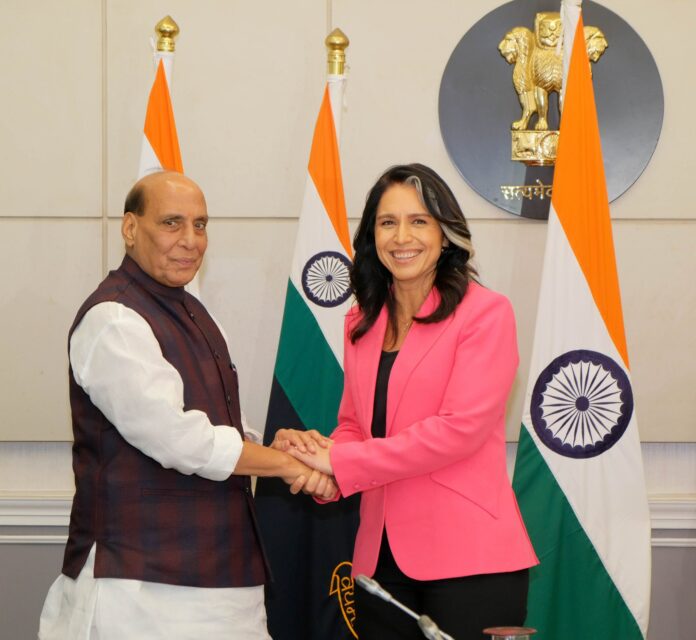India’s Defence Minister Rajnath Singh met with U.S. Director of National Intelligence Tulsi Gabbard in New Delhi on Monday (March 17), to discuss pressing security concerns and intelligence-sharing mechanisms. The discussions reportedly focused on counterterrorism, regional stability, and the activities of pro-Khalistan groups operating in the United States.
This meeting comes at a time of evolving geopolitical shifts, as both India and the U.S. seek to strengthen their strategic partnership. With increasing concerns over transnational extremist movements and cyber threats, the dialogue between Singh and Gabbard is expected to deepen intelligence cooperation between the two nations.
Focus on Khalistani Extremism and Security Threats
One of the key issues raised by Rajnath Singh was the increasing activities of the pro-Khalistan group Sikhs for Justice (SFJ), which has been involved in anti-India rhetoric and actions on American soil. The Indian government has long expressed concerns over the group’s links to Pakistan’s Inter-Services Intelligence (ISI) and its reported collaborations with militant outfits like Babbar Khalsa.
Singh urged Gabbard to consider designating SFJ as a terrorist organization, citing its involvement in inciting violence against Indian diplomats and Hindu religious sites in the U.S. This follows recent incidents where pro-Khalistan groups targeted Indian consulates and attempted to vandalize temples in North America.
The Indian government has raised similar concerns with Canadian and British authorities regarding extremist elements exploiting democratic freedoms in Western nations. With the U.S. being a key ally, India is looking for stronger action against groups that promote separatism and destabilization.
Tulsi Gabbard’s Visit and Strategic Significance
This is Tulsi Gabbard’s first visit to India as the U.S. Director of National Intelligence. A former member of the U.S. Congress from Hawaii, she is the first Hindu-American to hold such a high-level intelligence position. Gabbard has been an advocate for stronger U.S.-India relations and has previously interacted with Indian leadership, including Prime Minister Narendra Modi.
Her appointment as the chief of U.S. intelligence signals a shift in Washington’s approach towards India, especially in counterterrorism cooperation and Indo-Pacific security. Her familiarity with India’s security concerns could pave the way for deeper intelligence-sharing mechanisms between the two nations.
India-U.S. Intelligence Cooperation and Broader Security Concerns
Beyond Khalistani extremism, the meeting covered broader security threats, including terrorism, cybersecurity, and regional stability. India and the U.S. have been strengthening their intelligence cooperation in recent years, particularly in the wake of China’s growing influence in the Indo-Pacific and Pakistan’s continued support for terrorist networks.
Both countries have an active intelligence-sharing agreement under frameworks like the Quad and the Five Eyes partnership. The emphasis on counterterrorism is crucial, especially given the resurgence of extremist groups in Afghanistan following the Taliban’s return to power.
Additionally, cyber threats and misinformation campaigns were likely discussed, given the rise of digital warfare tactics used by adversarial states. The U.S. has been increasingly concerned about Chinese cyber espionage, while India has faced several cyberattacks allegedly backed by state actors. Strengthening joint cybersecurity measures would be a natural extension of the discussions between Singh and Gabbard.
Expanding the India-U.S. Defence and Intelligence Partnership
This meeting is part of a broader effort to enhance the India-U.S. strategic partnership. The two countries have already signed many defence agreements, including:
- The Basic Exchange and Cooperation Agreement (BECA): Allows for real-time intelligence sharing between the Indian and U.S. armed forces.
- The Communications Compatibility and Security Agreement (COMCASA): Enhances secure communication between the two militaries.
- The Logistics Exchange Memorandum of Agreement (LEMOA): Facilitates mutual access to military bases for logistical support.
These agreements have strengthened military ties, but intelligence cooperation remains a crucial pillar. Gabbard’s visit signals Washington’s intent to deepen this relationship further.
Strengthening Strategic Ties
Singh and Gabbard’s meeting highlights the growing strategic convergence between India and the United States. As global security threats become more complex, intelligence-sharing and counterterrorism efforts will define the future of this partnership.
India expects more proactive measures from Washington against extremist groups operating within the U.S., particularly those linked to the Khalistan movement. The U.S. sees India as a big strategic ally in countering China’s regional influence and maintaining stability in the Indo-Pacific.
With the U.S. presidential elections approaching, the Biden administration’s approach towards India will be closely watched. If intelligence cooperation continues to expand, it could mark a new era in bilateral relations, with both nations collaborating more closely against common security threats.
This high-profile engagement sets the stage for further diplomatic and defence discussions, reinforcing the shared commitment of India and the U.S. to global security.



